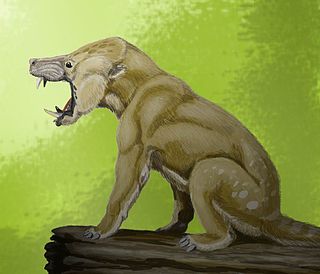
Perissodactyla is an order of ungulates. The order includes about 17 living species divided into three families: Equidae, Rhinocerotidae (rhinoceroses), and Tapiridae (tapirs). They typically have reduced the weight-bearing toes to three or one of the five original toes, though tapirs retain four toes on their front feet. The nonweight-bearing toes are either present, absent, vestigial, or positioned posteriorly. By contrast, artiodactyls bear most of their weight equally on four or two of the five toes: their third and fourth toes. Another difference between the two is that perissodactyls digest plant cellulose in their intestines, rather than in one or more stomach chambers as artiodactyls, with the exception of Suina, do.

Paenungulata is a clade of "sub-ungulates", which groups three extant mammal orders: Proboscidea, Sirenia, and Hyracoidea (hyraxes). At least two more possible orders are known only as fossils, namely Embrithopoda and Desmostylia.

Ambulocetus is a genus of early amphibious cetacean from the Kuldana Formation in Pakistan, roughly 48 or 47 million years ago during the Early Eocene (Lutetian). It contains one species, Ambulocetus natans, known solely from a near-complete skeleton. Ambulocetus is among the best-studied of Eocene cetaceans, and serves as an instrumental find in the study of cetacean evolution and their transition from land to sea, as it was the first cetacean discovered to preserve a suite of adaptations consistent with an amphibious lifestyle. Ambulocetus is classified in the group Archaeoceti—the ancient forerunners of modern cetaceans whose members span the transition from land to sea—and in the family Ambulocetidae, which includes Himalayacetus and Gandakasia.
Pilgrimella is an extinct early Eocene genus of anthracobunid, a group of stem perissodactyls. It was a ground dwelling grazer with massive bilophodont molars Dental remains of this animal have been found in Chorlakki, Punjab province, Pakistan, and in the Subathu Formation in North-West India.

Condylarthra is an informal group – previously considered an order – of extinct placental mammals, known primarily from the Paleocene and Eocene epochs. They are considered early, primitive ungulates. It is now largely considered to be a wastebasket taxon, having served as a dumping ground for classifying ungulates which had not been clearly established as part of either Perissodactyla or Artiodactyla, being composed thus of several unrelated lineages.

Phenacodus is an extinct genus of mammals from the late Paleocene through middle Eocene, about 55 million years ago. It is one of the earliest and most primitive of the ungulates, typifying the family Phenacodontidae and the order Perissodactyla.

Tethytheria is a clade of mammals that includes the sirenians and proboscideans, as well as the extinct order Embrithopoda.

Panperissodactyla is a clade of ungulates containing living order Perissodactyla and all extinct ungulates more closely related to Perissodactyla than to Artiodactyla.
Jozaria is an extinct genus of stem perissodactyl from the Early to Middle Eocene of the Kuldana Formation of Kohat, Pakistan. It and other anthracobunids were formerly classified with proboscideans.

Anthracobunidae is an extinct family of stem perissodactyls that lived in the early to middle Eocene period. They were originally considered to be a paraphyletic family of primitive proboscideans possibly ancestral to the Moeritheriidae and the desmostylians. The family has also thought to be ancestral to the Sirenia.

Anthracobune is an extinct genus of stem perissodactyl from the middle Eocene of the Upper Kuldana Formation of Kohat, Punjab, Pakistan.
Ishatherium is an extinct genus of ungulate from the early Eocene of the Subathu formation in northwestern India.
Lammidhania is an extinct genus of anthracobunids, which lived from the early to middle Eocene period. Its fossil remains were discovered in 1940 in the Chorlakki locality of the Punjab province of Pakistan.
Nakusia is an extinct genus of ungulate from the early Eocene epoch, described in 1999 in the Ghazij formation of Baluchistan, Pakistan. It was classified as an anthracobunid in 1999 but was suggested in a 2014 cladistic analysis to be more likely to belong to Quettacyonidae or Cambaytheriidae.
Hsanotherium is an extinct genus of early ungulate from the middle Eocene, described in 2000 in the Pondaung Formation, Myanmar.

Meniscotherium is an extinct genus of dog-sized mammal which lived 54–38 million years ago. It was a herbivore and had hooves. Fossils have been found in Utah, New Mexico. and Colorado. Many individuals have been found together, indicating that it lived in groups.
Indobune is an extinct genus of ungulate endemic to Asia during the Eocene from 55.8—48.6 Ma, living for approximately 7.2 million years.
Paschatherium is a small extinct mammal of the Perissodactyla order, with an insectivore-like dentition. Its morphology indicates an arboreal form, adapted climbing and running on trees. Paschatherium must have been extremely numerous in the latest Paleocene and earliest Eocene of Europe, since it makes up the majority of all mammal fossils in some fossil sites.

Phenacodontidae is an extinct family of large herbivorous mammals traditionally placed in the “wastebasket taxon” Condylarthra, which may instead represent early-stage perissodactyls. They lived from the late early Paleocene to early middle Eocene and their fossil remains have been found in North America and Europe. The only unequivocal Asian phenacodontid is Lophocion asiaticus.
Cambaytherium is an extinct genus of placental mammals in the family Cambaytheriidae whose fossils were found in an open pit coal mine located in Gujarat, India. The mine was a treasure trove full of teeth and bones, over 200 of which were identified as belonging to Cambaytherium thewissi. The fossils were dated to the Early Eocene, 54.5 million years ago, making them slightly younger than the oldest known fossils belonging to the order Perissodactyla.




















